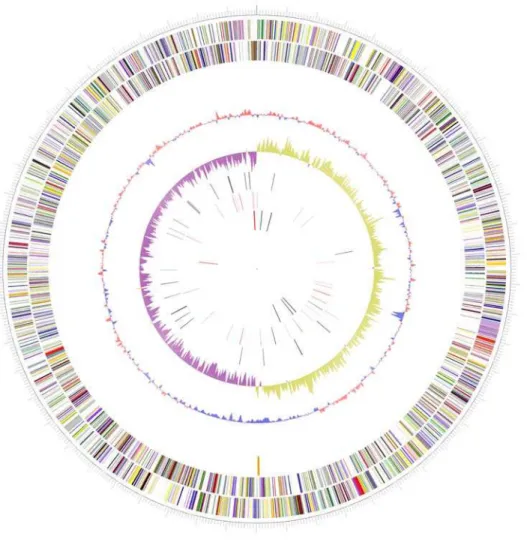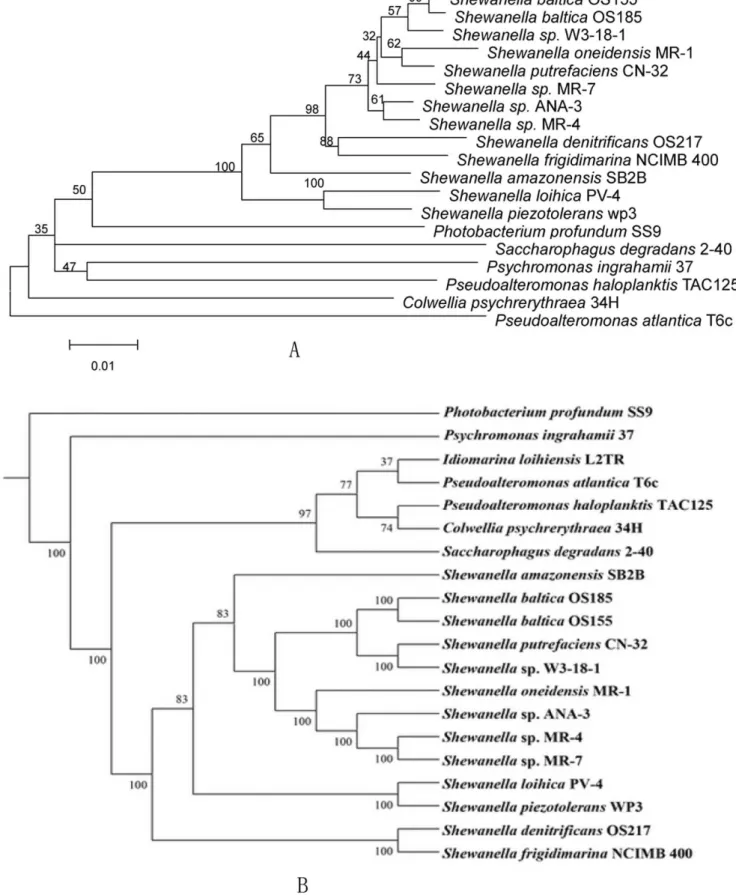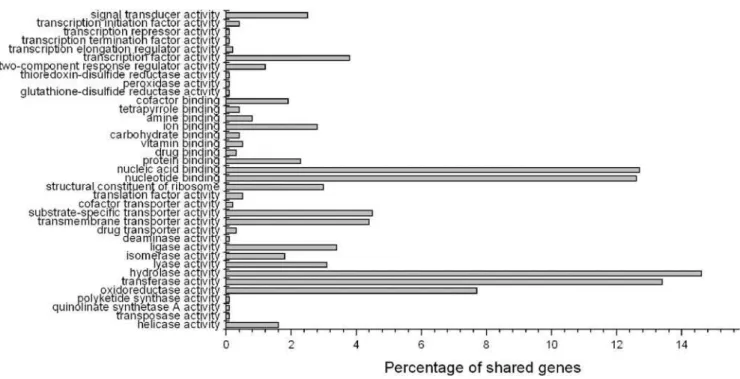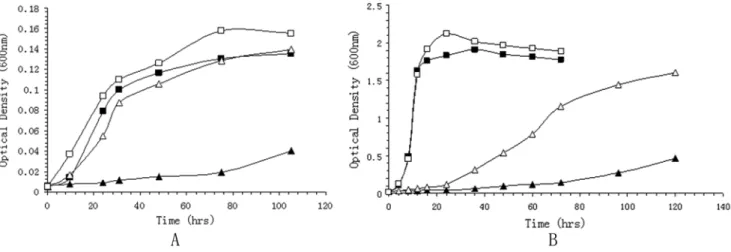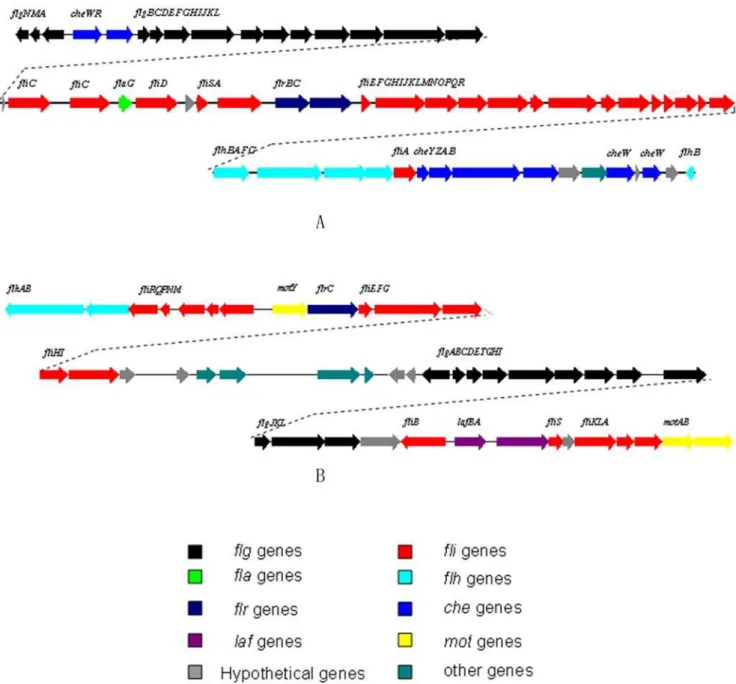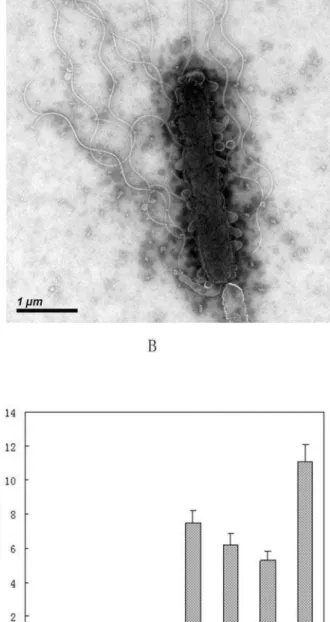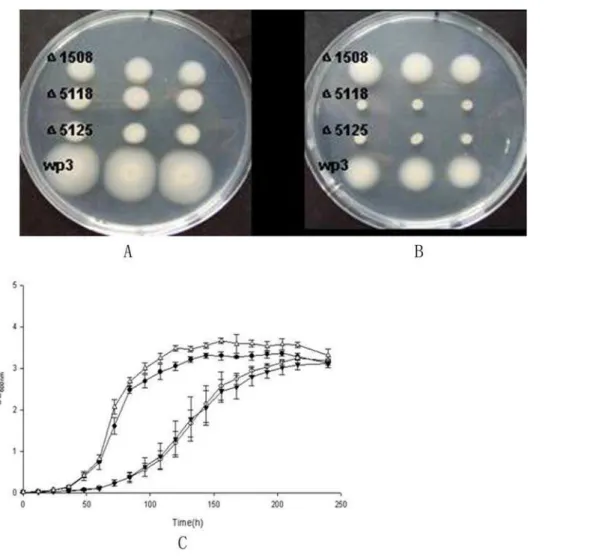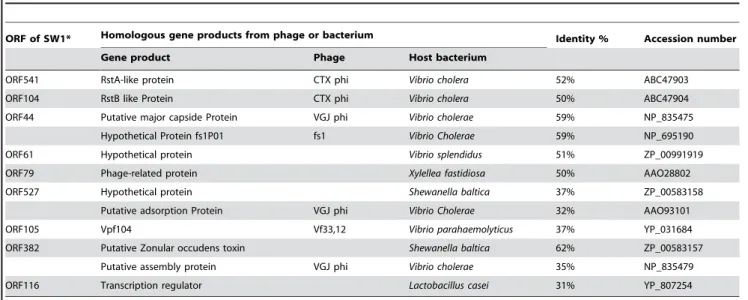Piezotolerant and Psychrotolerant Deep-Sea Iron
Reducing Bacterium
Shewanella piezotolerans
WP3
Fengping Wang1,2., Jianbin Wang3,4., Huahua Jian1,2
, Bing Zhang3,4, Shengkang Li1,2, Feng Wang1,2, Xiaowei Zeng4, Lei Gao5, Douglas Hoyt Bartlett6, Jun Yu3,4, Songnian Hu3,4*, Xiang Xiao1,2*
1Key Laboratory of Marine Biogenetic Resources, State Oceanic Administration, Xiamen, People’s Republic of China,2Third Institute of Oceanography, State Oceanic Administration, Xiamen, People’s Republic of China,3Beijing Institute of Genomics, Chinese Academy of Sciences, Beijing, People’s Republic of China,4James D. Watson Institute of Genome Sciences, Zhejiang University, Hangzhou, People’s Republic of China,5The T-Life Research Center, Fudan University, Shanghai, People’s Republic of China,6Center for Marine Biotechnology and Biomedicine, Marine Biology Research Division, Scripps Institution of Oceanography, University of California, San Diego, La Jolla, California, United States of America
Abstract
Shewanellaspecies are widespread in various environments. Here, the genome sequence ofShewanella piezotoleransWP3, a piezotolerant and psychrotolerant iron reducing bacterium from deep-sea sediment was determined with related functional analysis to study its environmental adaptation mechanisms. The genome of WP3 consists of 5,396,476 base pairs (bp) with 4,944 open reading frames (ORFs). It possesses numerous genes or gene clusters which help it to cope with extreme living conditions such as genes for two sets of flagellum systems, structural RNA modification, eicosapentaenoic acid (EPA) biosynthesis and osmolyte transport and synthesis. And WP3 contains 55 open reading frames encoding putativec-type cytochromes which are substantial to its wide environmental adaptation ability. Themtr-omcgene cluster involved in the insoluble metal reduction in theShewanellagenus was identified and compared. The two sets of flagellum systems were found to be differentially regulated under low temperature and high pressure; the lateral flagellum system was found essential for its motility and living at low temperature.
Citation:Wang F, Wang J, Jian H, Zhang B, Li S, et al. (2008) Environmental Adaptation: Genomic Analysis of the Piezotolerant and Psychrotolerant Deep-Sea Iron Reducing BacteriumShewanella piezotoleransWP3. PLoS ONE 3(4): e1937. doi:10.1371/journal.pone.0001937
Editor:Christophe Herman, Baylor College of Medicine, United States of America
ReceivedOctober 31, 2007;AcceptedFebruary 28, 2008;PublishedApril 9, 2008
Copyright:ß2008 Wang et al. This is an open-access article distributed under the terms of the Creative Commons Attribution License, which permits unrestricted use, distribution, and reproduction in any medium, provided the original author and source are credited.
Funding:This work was financially supported by China COMRA foundation DYLY0202-03, NSFC fund (40625016, 40776095).
Competing Interests:The authors have declared that no competing interests exist.
* E-mail: husn@genomics.org.cn (SH); xxwfp@public.xm.fj.cn (XX)
.These authors contributed equally to this work.
Introduction
The deep sea, which is characterized by extremely low temperatures (,5uC) and high pressures (up to 110 MPa), comprises the bulk of the world’s oceans. Microorganisms are known to thrive in this extreme environment, however, knowledge of the adaptations of deep-sea microorganisms to the psychro-sphere/piezosphere remains fragmentary [1,2,3]. Recently ge-nome sequence information of bacteria from high pressure and/or cold environments (includingPhotobacterium profundum[4],Colwellia psychrerythraea [5], Idiomarina loihiensis [6] and Pseudoalteromonas haloplanktis [7]) has indicated some of the relevant adaptation strategies. However, much more information is needed.
Members of the genusShewanellainhabit various environments, and are well known for their versatile respiratory capabilities, coupling the oxidation of diverse substrates to the respiration of many different electron acceptors [8]. As a result of these properties, Shewanella strains have been proposed as candidates for bioremediation of metal and organic contaminants. Since potential clean up sites often include cold subsurface settings, it is essential to understand how these conditions influenceShewanella evolution, adaptation and ecology. One Shewanella species, Shewanella oneidensis MR-1, isolated from Oneida Lake sediments
(NY, USA) [9] has been the subject of detailed genomic and proteomic investigations. The genome sequence of MR-1 has provided invaluable information about its respiratory capabilities [10,11]. However, still little is known about environmental acclimation or evolution within this genus [12,13]. At present, there are more than 18Shewanellastrains from various environ-ments that have been sequenced by the Joint Genome Institute and other organizations [10,14]. These sequences provide a powerful frame of reference for additional genomic analyses of newShewanellaisolates possessing distinctive phenotypes.
sequence and related functional analysis of WP3. In addition, we compared the WP3 genome with other Shewanella genomes, in particular with S. oneidensis MR-1. This is the first detailed comparative genomic analysis of Shewanella species inhabiting dramatically different environments (shallow lake versus deep sea).
Results and Discussion
General genome features
The WP3 genome consists of a single circular chromosome of 5,396,476 bp with 4,944 predicted genes (Fig. 1). WP3 has the largest genome size among the sequenced Shewanella genomes. General features of the WP3 genomes are presented in Table 1. Of these predicted proteins, 3,326 (67.3%) are similar to known proteins in current databases, 877 (17.7%) are conserved hypothetical proteins, and 741 (15.0%) are hypothetical proteins which have no database match (see Supplementary Table S1, especially the 554 hypothetical proteins of 30–100
amino-acid-in-length). The genome of WP3 is mostly related toS. loihicaPV-4 genome (supplementary Tabel S2), a psychrotolerant bacterium isolated from iron-rich microbial mats at an active, deep-sea, hydrothermal Naha vent (1,325 m below sea level) located on the South Rift of Loihi Seamount, Hawaii [21,22]. WP3 and PV-4 have extensive regions of similar gene order (synteny), as revealed by an obvious ‘‘X’’ pattern when the two genomes are aligned (figure not shown); this pattern indicates thatShewanellagenomes have undergone extensive inversions around the origin and terminus, as has been seen in other closely related bacteria [23].
Proteome phylogenetic analysis
We used a whole proteome phylogenetic analysis method which utilizes the oligopeptide content, i.e., frequency of amino acid K strings in the complete proteomes to infer the evolutionary relatedness of Shewanella species [24]. Our analysis includes 13 sequencedShewanella:S. balticaOS185, OS155;S. putrefaciensCN-32; S. sp.W3-18-1;S. amazonensisSB2B;S. oneidensisMR-1;S.sp. ANA-3;
Figure 1. Circular representation of theShewanella piezotoleransWP3 genome.From the outside inward: the first and second circles show predicted protein-coding regions on the plus and minus strands, by biological role: translation/ribosome structure/biogenesis, pink; transcription, olive drab; DNA replication/recombination/repair, forest green; cell division/chromosome partitioning, light blue; posttranslational modification/ protein turnover/chaperones, purple; cell envelop biogenesis, red; cell motility/secretion, plum; inorganic ion transport/metabolism, dark sea green; signal transduction mechanisms, medium purple; energy production/conversion, dark olive green; carbohydrate transport/metabolisms, gold; amino acid transport/metabolism, yellow; nucleotide transport/metabolism, orange; coenzyme transport/metabolism, tan; lipid transport/metabolism, salmon; secondary metabolites biosynthesis/transport/catabolism, light green; defense mechanism, black; general function prediction only, dark blue; function unknown and hypothetical protein, gray. The third circle shows G+C content percentage in relation to the mean G+C% for the chromosome.
The fourth circle shows GC skew. The fifth circle shows insertion sequences, retrotransposons (black) and prophage (orange). The sixth and seventh circles show tRNA genes and rRNA operons, with blue or black on the plus strand and red on the minus one.
MR-4; MR-7; S. loihica PV-4; S. piezotolerans WP3; S. denitrificiens OS217;S. frigidimarinaNCIMB400. The whole proteome phyloge-netic tree is similar, but not entirely consistent with the 16S rRNA gene phylogenetic tree, which is widely used for species phylogenetic relationship analysis (Fig. 2A, B). Both of the proteome and 16S rRNA gene phylogenetic analysis showed that strain WP3 and PV-4, OS217 and NCIMB400 are closest related, respectively. In the proteome tree, MR-1, ANA-3, MR-4, and MR-7 formed a cluster, while strain OS185, OS155, CN-32, W3-18-1 formed another cluster. On the other hand, there is no clear cluster seperation formed by these eight strains in the 16S rRNA gene tree. Both analyses indicate thatS. oneidensisMR-1, which has been subjected to a detail genomic and proteomic investigation, evolved after the species PV4 and WP3 during theShewanellagenus evolution.
Functional classification and genome comparison AsS. oneidensisMR-1 has been used for detailed genomic and proteomic investigations, the COG (Clusters of Orthologous Groups) [25] functional classification of WP3 was compared with that of MR-1. The data revealed that the percentage of genes involved in most functional categories in the two genomes are quite similar (P = 0.6815). WP3 has slight increase in genes involved in cell wall/membrane/envelope biogenesis (M), energy production and conversion (C), intracellular trafficking , secretion, and vesicular transport (U) and inorganic ion transport and metabolism (P), while S. oneidensishas more genes in replication, recombination and repair (L), cell cycle control, cell division, chromosome partitioning (D), signal transduction (T), posttrans-lational modification, protein turnover, chaperones (O), nucleotide transport and metabolism (F) and coenzyme transport and metabolism (H). There are many more unclassified genes in WP3 (1823, 36.9%) thanS. oneidensis(1365, 30.5%). Comparing the 13 complete Shewanellagenome sequences mentioned above, 1,591 common genes were found. These common genes are supposed to constitute the core genome of theShewanellagenus. Of all the shared genes, most belong to nucleic acid binding, nucleotide binding, hydrolase activity, transferase activity and oxidoreductase activity based on Gene Ontology term (Fig. 3).
Duplicated genes
Compared with other sequencedShewanellagenomes, the WP3 genome is the largest. We compared paralogous gene families
(transposases excluded) in MR-1 and WP3 genomes. The results clearly indicated that to each pairs of corresponding gene families (paralog) in both genomes, WP3 usually has much more gene number in these families than MR-1has: WP3 contains 225 paralogous families which have more gene members (432 more genes) than their ortholog families in MR-1, while only 102 families of larger gene content (165 more genes) are present in MR-1. Supplementary Table S3 lists the expanded paralogous families in both genomes (having.2 more genes in one paralogous gene family compared to the other and.20% more genes of the average family member size; 31 versus 5 families are presented). In WP3, these expanded families are primarily involved in transport, secretion, energy metabolism and transcriptional regulation. The existence of additional duplicated genes could provide more capacity for coping with environmental change and less selective pressure because of their redundancy in WP3.
Electron transport
S. oneidensis contains 42 putative cytochrome c genes which encode c-type cytochromes as constituents of its diversified respiratory network [11]. WP3 also can use a variety of electron acceptors such as nitrate, fumarate, trimethylamine N-oxide (TMAO), dimethyl sulfoxide (DMSO), and insoluble metals during anaerobic growth [20]. By careful pattern searching and BLAST analyses [11], the cytochromec genes in WP3 genome were identified as listed in Table S4. Its genome contains 55 putative c-type cytochrome genes including 1 with 11 heme-binding sites, 11 with 10 heme-heme-binding sites, 5 with 7 or 8 sites, and 12 with 4 or 5 sites. According to sequence similarities, the cytochromescgenes in WP3 could be divided into 17 groups as shown in Supplementary Table S5. WP3 contains many more decaheme cytochomecand nitrite reductase genes than MR-1 (17 and 5 versus 10 and 1, respectively), while it has less fumarate reductase genes than MR-1. Among the sequencedShewanella, only theS. denitrificiens OS217 does not appear to be able to reduce metals. There are 10 hypothetical outer membrane lipoproteins in WP3 which are probably involved in the insoluble substance reduction. ThemtrABC/omcAgene cluster which is known in MR1 to participate in the metal reduction is conserved in all the Shewanellagenomes except OS217. Fig. 4 shows themtrCABoperon and its upstream and downstram genes in theShewanellagenomes. Upstream themtrBAC operon, anomcA or hypotheticalomcA like Table 1.General features of twoShewanellagenomes.
Genome feature S. piezotoleransWP3 chromosome S. oneidensisMR-1
chromosome plasmid
Size, bases 5,396,476 4,969,803 161,613
G+C content, % 43.2 46 43.7
Number of predicted ORFs 4,944 4,324 148
Average ORF length, bases 926 959 780
Coding density, % 84.4 83.4 71.5
Genes with orthologue in each other 3,167 3,016 32
Genes without orthologue in each other 1,777 1,308 116
rRNA operons 8 9 0
16S-23S-5S 7 9 0
16S-23S-5S-5S 1 0 0
Number of tRNAs 89 102 0
Figure 2. Phylogenetic tree based on 16S rRNA (A) and whole proteome analysis (B).The phylogenetic tree of the 16S rRNA gene sequences from variousShewnaella species was constructed by neighbor-joining method using the programs of MEGA package. 1000 trial of bootstrap analysis was used to provide confident estimates for phylogenetic tree topologies. The phylogenetic tree based on the whole proteome sequences of the strains was constructed as described in the materials and methods with 100 trial of bootstrap.
genes follow. Four types ofomcAgenes, here named asomcA-1to omcA-4,were identified. Strains CN32 and W3-18-1 contain an 11 heme-binding cytochrome c gene-omcA2, and both of these two strains together with NCIMB400 lack the mtrDEF which are conserved in some of theShewanellagenomes. WP3 also contains an 11 heme-bindingcytCgene-swp3899 which is not involved in themtr-omcgene cluster. The protein OmcA and MtrC are known to form a complex to reduce metal oxides in vitro. Upstream the mtrC gene, strain SB2B contains two hypothetical omcA genes, while strain PV4 and WP3 contain 3 hypotheticalomcAlike genes.
Most of the gene cluster is preceded by a ferrous iron transporter gene cluster feoAB which is only absent in NCIMB400. Downstream the mtrCAB operon, there exists a phage SPO1 DNA polymerase domain protein (named asspoP) in most of the genomes. Reports have suggested that the membrane-based cytochrome respiratory system may not be fully functional at high pressure, and the expression of genes for some respiration components is regulated by hydrostatic pressure [5,26]. We are making cytC gene mutations to investigate the functions of the CytCs in WP3 living under different environments. The high Figure 3. Percentage of shared genes inShewanella.The function classification of shared genes in 13 comparedShewanella genomeswas based on Gene Ontology term. Of all common genes, those belong to nucleic acid binding, nucleotide binding, hydrolase activity, transferase activity and oxidoreductase activity are predominant.
doi:10.1371/journal.pone.0001937.g003
Figure 4. Themtr-omcgene cluster and its surrounding genes.Themtr-omcgene clusters in severalShewanellagenomes are illustrated. The conservedmtrBACoperon is boxed.hypPrepresents gene for hypothetical protein,spoPencodes for phage SPO1 DNA polymerase domain protein. 1, Shewanellasp. MR4;S.sp.ANA3;S. sp. MR7;S. balticaOS155; 2,S. oneidensisMR-1;S. balticaOS185; 3,S.frigidimarinaNCIMB400; 4,S.putrefaciensCN32; 5,S.sp. W3-18-1; 6,S. amazonensisSB2B; 7,S. LoihicaPV4; 8,S.piezotoleransWP3.
number of cytochromecgenes in WP3 could be an adaptation to high pressure deep-sea environments.
Metabolic pathways
Compared to MR-1, WP3 has a great number of genes involved in various metabolic pathways (Supplementary Table S6). These include genes for the catabolism of starch and sucrose, pentose, fructose and mannose, ascorbate and aldarate, galactose, nucle-otide sugars and aminosugars; glycan metabolism (e.g., glyco-sphingolipid and glycosaminoglycan); amino acid metabolism (e.g., arginine, proline and beta-alanine) amine and urea cycle metabolism; and the breakdown of assorted other compounds such as glycerolipids, porphyrins and chlorophyll. Besides these enzymes, there are also genes encoding specific transporters, transferases and regulators involved in the above pathways (Supplementary Table S7). WP3 inhabits an oligotrophic, cold and high pressure deep-sea environment. The existence of so many carbon and energy utilization pathways and osmolyte transport and synthesis systems is a reflection of the adaptation to this setting. Likewise, the absence of any light-activated photolyase genes indicates an existence free of ultraviolet light (in contrastS. oneidenis contains one deoxyribodipyrimidine photolyase gene). This is consistent with the absence of sunlight in the deep-sea environment WP3 inhabits.
WP3 contains eight putative sulfatase genes, whereasS. oneidensis contains only one (SO4628, sulfatase). Bacterial sulfatases are known to function primarily in sulfur scavenging. Since marine systems are characterized by high inorganic sulfur concentrations, the limitation of this element would be expected to be rare where WP3 is found. However, sulfatases have been observed in other marine bacteria. The marine bacterium Pirellula sp. strain 1 harbors 110 putative sulfatase genes in its genome, which is the largest number known at the present time [27]. It has been suggested thatPirellulasp. strain 1 uses the sulfatases to efficiently degrade sulfated glycopolymers to gain energy rather than to meet its sulfate requirements. The sulfatase genes in WP3 may have a similar function. In addition, there are three other WP3 specific genes, with four copies each, involved in sulfur metabolism (Supplementary Table S8). These appear to be sodium/sulphate symporters (COG0471), arylsulfatase regulators (Fe-S oxidoreduc-tase, COG0641), and glutathione S- transferases (COG0625).
WP3 Membrane Fluidity
A change in membrane fluidity is a well-established response of poikilothermic organisms to low temperature and high pressure exposure [3]. WP3 can synthesize eicosapentaenoic acid (EPA; 20:5), and its content in the cell membrane increases as a function of the decreased temperatures [19]. WP3 harbors a gene cluster (WP3546–3554) for eicosapentaenoic acid (EPA; 20:5) omega-3 polyunsaturated fatty acid synthesis. Five genes in this gene cluster have been shown essential for EPA synthesis [28]. Mutation of the orf2 gene which encodes the putative phosphopantetheinyl transferase (PPTase) diminished the EPA synthesizing capability of WP3, and theDorf2 WP3 strain showed much slower growth rate under low temperature or high pressure compared with the wild type strain (Fig. 5). On the other hand, in the deep-sea bacteriumPhotobacterium profundumSS9, it has been observed that EPA is not essential for the growth of SS9 at low temperature and high pressure. We are still not clear why EPA plays different roles in the environmental adaptation of WP3 and SS9. Comparison of the genome of WP3 with those of PV-4, Desulfotalea psychrophila Lsv54, Colwellia psychrerythraea 34H and Photobacterium profundum SS9, all of which are cold-adapted bacteria, only indicated the presence of a few features in common: WP3, PV-4, 34H and SS9 all contain the EPA synthesis gene cluster, and Lsv54 contains two copies ofb-keto-acyl-CoA synthase I, which elongates unsaturated fatty acids. This further illustrates that maintaining membrane physical structure is crucial for life in cold and/or high pressure environments, and this can be achieved by increasing the ratio of unsaturated fatty acids.
tRNA, rRNA modifications
WP3 contains seven pseudouridine synthase genes (COG1187), nine pseudouridylate synthase genes (COG0564) and three genes (COG0101, COG0130, COG4445) for RNA modification [29,30] (Supplementary Table S9). In general, bacteria only have 1–4 copies of these genes; this is the first report of so many pseudouridine synthase genes in a single bacteria genome. The high number of pseudouridine synthase genes was also observed in several of the Shewanellagenomes including PV4, MR-4, MR-7, CN-32, SB2B, OS155, 0S217, but absent in the MR1 genome. Khachaneet alreported that the uracil content of 16S rRNA in
Figure 5. Growth curve of WP3 and its mutant.The growth of WP3 and the WP3Dorf2 mutant under different temperature and pressure conditions were monitered by measuring the optical density of the cultutes at 0D600. For each measurement, triplicate cultures were measured simultaneously, and the average value was recorded. A: Growth of the strains at 0.1 MPa and 20 MPa. Wild type WP3 was grown at 0.1 MPa (%), or at 20 MPa (&); WP3Dorf2 mutant grown at 0.1 MPa (m) or 20 MPa(D); B: Growth of the strains at 4uC and 20uC. Wild type WP3 was grown at 4uC (%), or at 20uC (&); WP3Dorf2 mutant grown at 4uC (m) or 20uC (D).
thermophilic and psychrophilic prokaryotes increase as their optimal growth temperatures drop [31]. Previous studies have also indicated that the maintenance of flexibility at low temperatures is important for tRNA function, and this is mainly achieved through post-transcriptional incorporation of dihydrour-idine in psychrophilic bacteria [32]. Cellular RNA contains a number of post-transcriptionally modified nucleosides, the most common of which is pseudouridine (y). Pseudouridine has been identified in tRNAs, rRNAs, snRNAs and/or snoRNAs for which the stability of their tertiary structure is important for function [29,33]. Pseudouridine synthases are the enzymes responsible for formation of theyresidues. InE. coli, the pseudouridine synthase RluD is responsible for the formation of y1911, y1915, and y1917 in 23S rRNA. Disruption of therluDgene and/or loss of the pseudouridine residues for which it is responsible resulted in a severe growth phenotype. RluD and/or they1911, y1915, and
y1917 residues formed by it are necessary for normal ribosome biogenesis, assembly, and function in E. coli [29,34]. The large number of genes for structural RNA modification in so many Shewanellagenomes may be one of the important mechanisms for the wide environmental adaptation and distribution of the genus.
Cell motility
Two sets of flagella genes are present in the WP3 genome (flagella I: swp1493-swp1550, flagella II: swp5082-swp5126, Fig. 6). Flagella I contains theflgM, flgN, fliJ and fliOgenes, which are missing in the flagella II gene cluster. Two stator proteins, MotY, MotAB (swp5089, swp5126,5127), responsible for converting proton motive force into torque against the rotor/switch, are found to be encoded in the flagella II gene cluster. No motor protein genes were found near the Fla I gene cluster area. However, two clustered genes, swp3615 and swp3616, which code
Figure 6. Gene organization map of two flagellum systems in WP3.A: Flagellum gene cluster I (polar): swp1493—swp1550; B: Flagellum gene cluster II (lateral): swp5082—swp5126. Arrow indicates gene transcription direction.
for putative MotB and MotA proteins are found in the genome far away from both of the flagella gene clusters. These two genes could be responsible for the rotor/switch function of Fla I or both. Sequence comparison results suggest that the flagella I and II in WP3 correspond to the polar and lateral flagella of V. parahaemolyticus [35]. The polar flagellum propels the bacterium in a liquid environment (swimming), while the lateral flagella are responsible for movement over surfaces or viscous environments (swarming) [36]. The WP3 cells in the liquid cultures only contains a single polar flagellum as observed by transmission electronic
microscope (Fig. 7A), while the lateral flagella was induced when cultivated on agar plates (Fig. 7B). The two flagella systems could facilitate the movement of WP3 cells in sediment pore fluids or in seawater from planktonic to surface-associated lifestyles. Interest-ingly, the two sets of flagellum systems were found to be inversely regulated by low temperature and high pressure (our unpublished microarray data). The differential regulation of the flagellum by temperature and pressure was verified by quantitative RT-PCR (Fig. 7C, D). As shown in the figure, the genes of lateral flagellum were highly up regulated by low temperature (4uC versus 20uC)
and slightly repressed by high pressure (20 MPa versus 0.1 MPa); while the genes of polar flagellum were largely repressed at low temperature and highly activated at high pressure. Mutants which have defects in polar or lateral flagella synthesis (WP3D1508 defect in polar flagellum; WP3D5118, WP3D5125 defect in lateral flagellum) showed decreased motility on 0.3% agar plates at 20uC (Fig. 8A). The mutant lacking lateral flagella completely lost motility at 4uC, while the mutant with a defect in the polar flagellum remained motile (Fig. 8B). This clearly indicated that the lateral flagellum is essential for the motility of the strain at low temperature. Strains WP3D5118 and WP3D5125 showed decreased growth rate compared to the wild type when grown at 4uC (Fig. 8C), while no growth arrest was observed at 20uC. This is the first demonstration of a requirement for a second flagellum system for growth at low temperature. The deep-sea bacterium Photobacterium profundum strain SS9 also has two sets of flagella genes [4] and thus the results presented here may extend to multiple genera of deep-sea microbes. The nature of the connection between swimming speed and anabolism and cell division are unknown and will require further investigation.
WP3 Phage
The WP3 genome includes only one prophage, a small 7,718 bp filamentous phage genome (named SW1), while MR-1 contains three prophages including one lambda-like phage (LambdaSo, 51,857 bp) and two phylogenetically distinct phages related to the E. coli Mu (MuSo1, 34,551 bp and MuSo2, 35,666 bp). Phage SW1 is integrated into the terminus of the chromosome and also exits as an extra-chromosomal plasmid. It contains nine putative open reading frames (ORF) as listed in Table 2. This is the first filamentous phage found in a Shewanellaspecies and could be a useful genetic engineering tool. Filamentous phages are unlike most other bacterial viruses in that the infected host remains viable and phages are continuously assembled and extruded from the cell in a concerted process [37]. Most of the sequences of the SW1 phage ORFs share low but significant similarities with those of Vibriofilamentous phages. SW1 could be assigned to genusInovirus of the familyInoviridaeof bacteriophages. The SW1 prophage is flanked by 13 base pair (GAATGCGCACAAT) direct repeats. Viable filamentous phage was successfully isolated from WP3 and it was found significantly induced and released at low temperature [38]. WP3 lives in the permanent cold deep-sea environments, at
Figure 8. Motility and growth assays of the WP3 strains.The motility assays for WP3 and the mutants (WP3D1508 has defect in polar flagellum; WP3D5118, WP3D5125 defect in lateral flagellum) were conducted on 0.3% agar plates at 20uC (A) or 4uC (B). Triplicates of each strain were spotted onto the soft agar, the motile ability of the strains were compared by observing the movements of the strains after 3 days at 20uC, or 7 days at 4uC. The growth of WP3 and the mutants at 4uC was monitered by measuring the optical density of the cultutes at 0D600. The mean values with standard deviations (indicated by vertical bars) from triplicate experiments are given. D represents the wild type WP3; N mutant WP3D1508; #WP3D5118.WP3D5125.
which condition the filamentous phage is highly induced and released into the environments. The significance of this character for the species environmental adaptation and evolution is still unclear. Similarity searches among sequencedShewanellagenomes indicated that two strains,Shewanella balticaOS155 andShewanella putrifaciens CN-32, contain sequences similar to those of filamen-tous phage. These two DNA fragments are adjacent to the phage integrase gene, suggesting that they are derived through phage mediated horizontal gene transfer. The roles of filamentous phage inShewanellaevolution await further clarification.
Conclusion
The complete genome sequence of the deep-sea bacterium Shewanella piezotolerans WP3 reflects a capacity for coping with diverse energy sources and variable physical conditions. The WP3 genome contains genes or gene clusters which enhance its capacity for nutrient acquisition, energy production, macromolecule synthesis and protein function under deep-sea conditions. These include genes for two sets of flagellum systems, structural RNA modification, functional EPA synthesis, and osmolyte synthesis and transport. WP3 contains 55 putative cytochrome c genes, indicating a versatile respiratory adaptation strategy and bioener-getic modification of electron flow. Understanding how different Shewanella species sense and respond to diverse physiochemical parameters holds the promise of extending the environmental range of their biotechnological applications.
Methods
Bacterial cultivation
Shewanella piezotoleransWP3 was isolated from a shallow sediment sample obtained from the western Pacific Ocean (E142u309080, N8u009110) at a water column depth of 1914 m. It was grown in modified Marine 2216E broth at 20uC [20]. For high pressure incubation of WP3, overnight log phase atmospheric pressure cultures of WP3 cells were grown and then diluted 1000-fold by the same medium, transferred into sterile injection syringes and placed inside pressure vessels. Cultures were then incubated at 20uC at either atmospheric pressure or at 20 MPa with the same method as described elsewhere [39].
Sequencing and assembly
DNA isolation, cloning, sequencing, and assay were performed as described for other genomes sequenced by Beijing Institute of Genomics/Hangzhou Genomics Institute ( BIG/HGI) [40,41]. We constructed three pUC18 plasmid libraries, with insertion size of 2K, 3K, and 5K respectively. Sequences were generated by using ABI3730 and MegaBase 1000 automatic sequencers and assembled by Phred/Phrap/Consed software [42,43,44]. Scaffolds were established by contigs, according to linking information from forward and reverse sequence ends of each clone. Sequence gaps were closed by re-sequencing the end sequences of each contig, primer walking on linking clones, and by sequencing PCR products from genomic DNA. Consensus sequence coverage and base ambiguities were improved by re-sequencing existing DNA samples and by sequencing additional PCR products, together with manual editing. All repeated regions were verified with PCR amplification across the repeat and sequencing the product. The final genome is based on 85,529 reads, with a total coverage of 6.52X (Q20) and overall base error probability 0.26/10 Kb.
Genome analysis
The replication origin was determined by sequence similarity to the origin ofShewanella oneidensisand GC nucleotide skew analysis [45]. An initial set of open reading frames (ORFs) were predicted by Glimmer software [46]. Both predicted ORFs and intergenic sequences were subjected for further manual inspections. All predicted proteins .30 amino acids were searched against GenBank non-redundant protein database using BLAST program [47]. Frameshifts and point mutations were detected and corrected where appropriate. Remaining frameshifts and point mutations are considered to be authentic and were annotated as ‘‘authentic frameshift’’ or ‘‘authentic point mutation’’, or, in the case of multiple lesions within a single ORF, ‘‘degenerate’’. tRNAs were predicted by tRNAscan-SE [48].
The predicted proteins were further investigated by InterProS-can program to InterPro database [49], which now included 14 integrated databases of protein families, domains and functional sites. Functional classification of WP3 proteins were done according to COG functional category [25]. Metabolic pathways were analysis with KEGG database [50].
Table 2.Putative ORFs in the SW1 phage sequence and the BLAST search results.
ORF of SW1* Homologous gene products from phage or bacterium Identity % Accession number
Gene product Phage Host bacterium
ORF541 RstA-like protein CTX phi Vibrio cholera 52% ABC47903
ORF104 RstB like Protein CTX phi Vibrio cholera 50% ABC47904
ORF44 Putative major capside Protein VGJ phi Vibrio cholerae 59% NP_835475
Hypothetical Protein fs1P01 fs1 Vibrio Cholerae 59% NP_695190
ORF61 Hypothetical protein Vibrio splendidus 51% ZP_00991919
ORF79 Phage-related protein Xylellea fastidiosa 50% AAO28802
ORF527 Hypothetical protein Shewanella baltica 37% ZP_00583158
Putative adsorption Protein VGJ phi Vibrio Cholerae 32% AAO93101
ORF105 Vpf104 Vf33,12 Vibrio parahaemolyticus 37% YP_031684
ORF382 Putative Zonular occudens toxin Shewanella baltica 62% ZP_00583157
Putative assembly protein VGJ phi Vibrio cholerae 35% NP_835479
ORF116 Transcription regulator Lactobacillus casei 31% YP_807254
*The gene names are designated by the number of amino acid residues they contain.
Proteome phylogenetic analysis
The whole proteome phylogenetic analysis of the speices were conducted by the Composition Vector method as described by Qiet al.[24]. First, we collected all amino acid sequences of a species, and then calculated the frequency of appearance of overlapping oligopeptides of length K. A random background needed to be subtracted from these frequencies by using a Markov model of order (K22) in order to diminish the influence of random neutral mutations at the molecular level and to highlight the shaping role of selective evolution. Then, we put the "normalized" frequencies in a fixed order; a composition vector of dimension 20K was obtained for each species. And the correlation C (A, B) between two species A and B was determined by taking projection of one normalized vector on another, i.e., taking the cosine of the angle between them. Finally, the normalized distance between the two species was defined to be D = (12C)/2. Once a distance matrix has been calculated, we then constructed phylogenetic trees by following the standard neighbor-joining method [51] in the Phylip package.
Bacterial cultivation for RNA isolation
WP3 was cultivated as introduced above. As for different temperature conditions, overnight log phase cultures of WP3 cells diluted 1000-fold by the same medium were grown at 4uC or 25uC for 3 days to reach an equivalent optical density. All samples were in triplicate for convenience of reproductivity. The cells were immediately centrifuged and RNA was extracted using TRI reagent-RNA/DNA/protein isolation kit (Molecular research center, Inc., Cincinnati, USA). The RNA was stored in 75% ethanol at280uC
Transmission Electron microscopy and swimming motility assay
Strains were grown to mid-log phase in 2216E medium, centrifuged(5000 g, 1 min), and resuspended in distill water. Samples were placed to a carbon-coated grid (200 mesh) and stained with 1% phosphotungstic acid (PTA). The grid was air dried and examined in a JEM-1230 microscope (JEOL, Tokyo, Japan). The swimming motility of the strains was assessed by examining their movements in the 0.3% 2216E agar plates. The assays were initiated by spotting 1ml of an overnight cell culture which has been normalized to an optical density of around 1.5 at
OD600nmonto the agar plates, then incubated at 20uC or 4uC for
3 days or a week, respectively.
Real Time RT-PCR
Three genes for polar and four genes for lateral flagellum synthesis were used for transcription analysis using the Real time RT-PCR method. The primer pairs of selected genes for real-time PCR were designed using Primer Express software (ABI). The primer sequences are: swp5109 For 59-CCCGCTCAGGT GCCATAG, swp5109Rev 59-CAA TAGG GCGGCCATCTAAG; swp5114 For 59 -AC-CTGTTTAGCTACGATCCCAGTA, swp5114Rev 59 -AGCCA-ACATATCA GCGTTGAAG; swp5118 For 59 -GCAGATGGTG-CATTAGACGAACT, swp5118Rev 59
-TTCACGCCGTTAGC-TGCTT; swp1499 For 59-GCAGCGCAGGCGAAACT,
swp1499Rev 59-TGCTGTTGTGCTTTG CTCATT; swp1511 For 59-GCACAAAGC GCGATTGC, swp1511Rev 59 -CGGT-TCTGTACCGCACCTAAG; swp1508 For 59-G GGTGGACTT-GATGTCAATGTG, swp1508 Rev 59 -TTAGAGGTTGAGTCG-CATCAAAAT; swp1519 For 59-GAAATGTG
AGCGAACTT-CAGTCA, swp1519Rev 59
-TGTCACTGTGGTATCGCCC-ATA; swp5125 For 59-GGCTGCACAACTACGATGTGTT, swp5125 Rev 59-GGCGGTTTGCCTTTAGCA. PCR cycling was conducted using 7500 System SDS software in reaction mixtures with total volumes of 25 ul containing 16Sybr Green I Universal PCR Master Mix (ABI), 0.5 uM each primer, 1 ul cDNA template. In this method, the amount of target was normalized to that of the reference gene swp0453 whose expression remains stable under various conditions, relative to the calibrator (The transcription levels of the genes at 0.1 MPa, or 20uC were set as 1). Real time RT-PCR assays were performed in triplicate for each sample, and a mean value and standard deviation were calculated for the relative RNA expression levels.
Accession number
The sequence has been deposited in GenBank with accession number CP000472.
Author Contributions
Conceived and designed the experiments: FW XX SH. Performed the experiments: JW HJ SL FW. Analyzed the data: JY FW XX SH BZ JW XZ LG. Contributed reagents/materials/analysis tools: XX SH. Wrote the paper: DB FW XX SH JW.
References
1. Bartlett DH (2002) Pressure effects on in vivo microbial processes. Biochim Biophys Acta 1595: 367–381.
2. Kato C, Bartlett DH (1997) The molecular biology of barophilic bacteria. Extremophiles 1: 111–116.
3. Bartlett DH (1999) Microbial adaptations to the psychrosphere/piezosphere. J Mol Microbiol Biotechnol 1: 93–100.
4. Vezzi A, Campanaro S, D’Angelo M, Simonato F, Vitulo N, et al. (2005) Life at depth:Photobacterium profundumgenome sequence and expression analysis. Science 307: 1459–1461.
5. Methe BA, Nelson KE, Deming JW, Momen B, Melamud E, et al. (2005) The psychrophilic lifestyle as revealed by the genome sequence of Colwellia psychrerythraea34H through genomic and proteomic analyses. Proc Natl Acad Sci U S A 102: 10913–10918.
6. Hou S, Saw JH, Lee KS, Freitas TA, Belisle C, et al. (2004) Genome sequence of the deep-sea gamma-proteobacteriumIdiomarina loihiensisreveals amino acid fermentation as a source of carbon and energy. Proc Natl Acad Sci U S A 101: 18036–18041.
7. Medigue C, Krin E, Pascal G, Barbe V, Bernsel A, et al. (2005) Coping with cold: The genome of the versatile marine Antarctica bacteriumPseudoalteromonas haloplanktisTAC125. Genome Res 15: 1325–1335.
8. Venkateswaran K, Moser DP, Dollhopf ME, Lies DP, Saffarini DA, et al. (1999) Polyphasic taxonomy of the genus Shewanella and description ofShewanella oneidensissp. nov. Int J Syst Bacteriol 49 Pt 2: 705–724.
9. Myers CR, Nealson KH (1988) Bacterial manganese reduction and growth with manganese oxide as the sole electron acceptor. Science 240: 1319–1321.
10. Heidelberg JF, Paulsen IT, Nelson KE, Gaidos EJ, Nelson WC, et al. (2002) Genome sequence of the dissimilatory metal ion-reducing bacteriumShewanella oneidensis. Nat Biotechnol 20: 1118–1123.
11. Meyer TE, Tsapin AI, Vandenberghe I, de Smet L, Frishman D, et al. (2004) Identification of 42 possible cytochrome C genes in the Shewanella oneidensis
genome and characterization of six soluble cytochromes. Omics 8: 57–77. 12. Gao H, Wang Y, Liu X, Yan T, Wu L, et al. (2004) Global transcriptome analysis
of the heat shock response ofShewanella oneidensis. J Bacteriol 186: 7796–7803. 13. Leaphart AB, Thompson DK, Huang K, Alm E, Wan XF, et al. (2006)
Transcriptome profiling of Shewanella oneidensis gene expression following exposure to acidic and alkaline pH. J Bacteriol 188: 1633–1642.
14. Benson DA, Karsch-Mizrachi I, Lipman DJ, Ostell J, Wheeler DL (2006) GenBank. Nucleic Acids Res 34: D16–20.
15. Kato C, Nogi Y (2001) Correlation between phylogenetic structure and function: examples from deep-seaShewanella. FEMS Microbiol Ecol 35: 223–230. 16. Kato C, Qureshi MH (1999) Pressure response in deep-sea piezophilic bacteria.
J Mol Microbiol Biotechnol 1: 87–92.
17. Xu MX, Wang P, Wang FP, Xiao X (2005) Microbial diversity in a deep-sea Station of Pacific Nodule Province, Studied via 16S rRNA Gene Sequences and Extremophile Cultivation. Biodiv and Conserv 14: 3363–3380.
18. Dianne K, Newman JFB (2002) Geomicrobiology: How Molecular-Scale Interactions Underpin Biogeochemical Systems. Science 296: 1071–1077. 19. Wang F, Wang P, Chen M, Xiao X (2004) Isolation of extremophiles with the
20. Xiao X, Wang P, Zeng X, Chen MX, Bartlett DH, et al. (2007)Shewanella psychrophilasp. nov.,Shewanella piezotoleranssp. nov., two newShewanellaspecies from west Pacific deep-sea sediment. Int J Syst Evol Microbiol 57: 60–65. 21. Roh Y, Gao H, Vali H, Kennedy DW, Yang ZK, et al. (2006) Metal reduction
and iron biomineralization by a psychrotolerant Fe(III)-reducing bacterium,
Shewanellasp. strain PV-4. Appl Environ Microbiol 72: 3236–3244.
22. Gao H, Obraztova A, Stewart N, Popa R, Fredrickson JK, et al. (2006)
Shewanella loihicasp. nov., isolated from iron-rich microbial mats in the Pacific Ocean. Int J Syst Evol Microbiol 56: 1911–1916.
23. Eisen JA, Heidelberg JF, White O, Salzberg SL (2000) Evidence for symmetric chromosomal inversions around the replication origin in bacteria. Genome Biol 1: RESEARCH0011.
24. Qi J, Wang B, Hao BL (2004) Whole Proteome Prokaryote Phylogeny Without Sequence Alignment: A K-String Composition Approach. J Mol Evol 58: 1–11. 25. Tatusov RL, Fedorova ND, Jackson JD, Jacobs AR, Kiryutin B, et al. (2003) The COG database: an updated version includes eukaryotes. BMC Bioinfor-matics 4: 41.
26. Tamegai H, Kawano H, Ishii A, Chikuma S, Nakasone K, et al. (2005) Pressure-regulated biosynthesis of cytochrome bd in piezo- and psychrophilic deep-sea bacteriumShewanella violaceaDSS12. Extremophiles 9: 247–253.
27. Glockner FO, Kube M, Bauer M, Teeling H, Lombardot T, et al. (2003) Complete genome sequence of the marine planctomycetePirellulasp. strain 1. Proc Natl Acad Sci U S A 100: 8298–8303.
28. Metz JG, Roessler P, Facciotti D, Levering C, Dittrich F, et al. (2001) Production of polyunsaturated fatty acids by polyketide synthases in both prokaryotes and eukaryotes. Science 293: 290–293.
29. Ofengand J, Malhotra A, Remme J, Gutgsell NS, Del Campo M, et al. (2001) Pseudouridines and pseudouridine synthases of the ribosome. Cold Spring Harb Symp Quant Biol 66: 147–159.
30. Charette M, Gray MW (2000) Pseudouridine in RNA: what, where, how, and why. IUBMB Life 49: 341–351.
31. Khachane AN, Timmis KN, dos Santos VA (2005) Uracil content of 16S rRNA of thermophilic and psychrophilic prokaryotes correlates inversely with their optimal growth temperatures. Nucleic Acids Res 33: 4016–4022.
32. Saunders NF, Thomas T, Curmi PM, Mattick JS, Kuczek E, et al. (2003) Mechanisms of thermal adaptation revealed from the genomes of the Antarctic ArchaeaMethanogenium frigidumandMethanococcoides burtonii. Genome Res 13: 1580–1588.
33. Ofengand J, Rudd KE (2000) The ribosome: Structure, function, antibiotics and cellular interactions. In: The ribosome: Structure, function, antibiotics, and cellular interactions Garrett RA et al, ed. Washington, DC: ASM Press. pp 175–189.
34. Gutgsell NS, Deutscher MP, Ofengand J (2005) The pseudouridine synthase RluD is required for normal ribosome assembly and function inEscherichia coli. RNA 11: 1141–1152.
35. Belas R, Simon M, Silverman M (1986) Regulation of lateral flagella gene transcription inVibrio parahaemolyticus. J Bacteriol 167: 210–218.
36. McCarter L, Hilmen M, Silverman M (1988) Flagellar dynamometer controls swarmer cell differentiation ofV. parahaemolyticus. Cell 54: 345–351.
37. Russel M, Linderoth NA, Sali A (1997) Filamentous phage assembly: variation on a protein export theme. Gene 192: 23–32.
38. Wang F, Wang FP, Li Q, Xiao X (2007) A novel filamentous phage from a deep-sea bacterium Shewanella piezotolerans WP3 is induced at low temperature. J Bacteriol 189: 7151–7153.
39. Li S, Xiao X, Li J, Luo J, Wang F (2006) Identification of genes regulated by changing salinity in the deep-sea bacterium Shewanellasp. WP3 using RNA arbitrarily primed PCR. Extremophiles 10: 97–104.
40. Bao Q, Tian Y, Li W, Xu Z, Xuan Z, et al. (2002) A complete sequence of theT. tengcongensisgenome. Genome Res 12: 689–700.
41. Chiu CH, Tang P, Chu C, Hu S, Bao Q, et al. (2005) The genome sequence of Salmonella enterica serovar Choleraesuis, a highly invasive and resistant zoonotic pathogen. Nucleic Acids Res 33: 1690–1698.
42. Ewing B, Hillier L, Wendl MC, Green P (1998) Base-calling of automated sequencer traces using phred. I. Accuracy assessment. Genome Res 8: 175–185. 43. Ewing B, Green P (1998) Base-calling of automated sequencer traces using
phred. II. Error probabilities. Genome Res 8: 186–194.
44. Gordon D, Abajian C, Green P (1998) Consed: a graphical tool for sequence finishing. Genome Res 8: 195–202.
45. Lobry JR (1996) Asymmetric substitution patterns in the two DNA strands of bacteria. Mol Biol Evol 13: 660–665.
46. Delcher AL, Harmon D, Kasif S, White O, Salzberg SL (1999) Improved microbial gene identification with GLIMMER. Nucleic Acids Res 27: 4636–4641.
47. Altschul SF, Madden TL, Schaffer AA, Zhang J, Zhang Z, et al. (1997) Gapped BLAST and PSI-BLAST: a new generation of protein database search programs. Nucleic Acids Res 25: 3389–3402.
48. Lowe TM, Eddy SR (1997) tRNAscan-SE: a program for improved detection of transfer RNA genes in genomic sequence. Nucleic Acids Res 25: 955–964. 49. Apweiler R, Attwood TK, Bairoch A, Bateman A, Birney E, et al. (2001) The
InterPro database, an integrated documentation resource for protein families, domains and functional sites. Nucleic Acids Res 29: 37–40.
50. Kanehisa M, Goto S, Kawashima S, Okuno Y, Hattori M (2004) The KEGG resource for deciphering the genome. Nucleic Acids Res 32: D277–280. 51. Saitou N, Nei M (1987) The neighbor-joining method: a new method for
